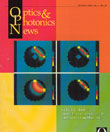
October 1993 Issue
- Micron Resolution Biomedical Imaging With Optical Coherence Tomography
- Electronic Holography For Imaging Through Tissue
- Snake Light Tomography
- Time-Gated Imaging With Nonlinear Optical Raman Interactions
- Looking Into A Bubble
- Going Right To The Source Over Standards
- Restoring Sight With Intraocular Lenses
- Photon Diffusion In Breast And Brain: Spectroscopy And Imaging
- Browse all Issues
Feature Articles
Micron Resolution Biomedical Imaging With Optical Coherence Tomography
In recent years, a number of powerful techniques have been developed for noninvasive biomedical imaging, including ultrasound, x-ray computed tomography (CT), magnetic resonance imaging (MRI), and positron emission tomography (PET). Each of these methods has different advantages and limitations for particular clinical applications. Optical imaging of tissue offers the potential of a noninvasive, high resolution diagnostic using non-ionizing radiation, and the possibility of using spectroscopic properties to distinguish tissue type and probe metabolic function. Recent advances in optics and photonics technology, including semiconductor lasers, fiber optics, and high quantum efficiency solid state detectors, suggest the possibility of a clinically viable optical biomedical imaging technology.
by Joseph A. Izatt, Michael R. Hee, David Huang, Eric A. Swanson, Charles P. Lin, Joel S. Schuman, Carmen A. Puliafito and James G. FujimotoElectronic Holography For Imaging Through Tissue
Image formation through inhomogeneous media, especially biological tissue, is an important and challenging problem, and is being addressed by many different approaches. Holography is one way that appears quite promising. In fact, there are a variety of holographic methods that may be used individually or in combination. The earliest application of holography to the problem of imaging through such highly scattering material as biological tissue was the holographic realization of the 1971 Duguay and Mattick principle of the first arriving light.
by E. Leith, E. Arons, H. Chen, Y. Chen, D. Dilworth, J. Lopez, M. Shih, P.-C. Sun, and G. VosslerSnake Light Tomography
Ultrafast Time-gated Snake Light 2D & 3D Images of Objects In Biomedical Media
by P.P. Ho, L. Wang, X. Liang, P. Galland, L.L. Kalpaxis and R.R. AlfanoTime-Gated Imaging With Nonlinear Optical Raman Interactions
The ability to image objects that are part of, embedded in, or viewed through densely scattering media has applications in many areas such as medical imaging, imaging through the atmosphere, materials inspection, and environmental assays. Images of such objects are generally blurred or obscured by multiple scattering of light as it traverses the scattering medium. Time-gated imaging allows viewing of such objects by preferentially detecting the light that is transmitted through the material in the least time, and therefore carries the image with the least degradation. Some of the techniques that have been used for such time-gated imaging are holography with nanosecond or femtosecond pulses, Kerr-gate shuttering, spatial correlation interferometry, optical coherence tomography, imaging with streak cameras, and electronic gating.
by J. Reintjes, M. Bashkansky, M.D. Duncan, R. Mahon, L.L. Tankersley, J.A. Moon, C.L. Adler, and J.M.S. PrewittLooking Into A Bubble
When people who are interested in optics look at a bubble, they frequently see a beautiful example of colors produced by the interference of light. It is not difficult, at the level of a general physics course, to calculate the path difference between light rays reflected from the two surfaces of a soap film, and for a given thickness of film determine which reflected wavelengths are enhanced by constructive interference and which are diminished by destructive interference.
by Robert GreenlerGoing Right To The Source Over Standards
In an attempt to keep our discussions of standards as broad as possible, I'd like to refer to a book I found recently, A Sourcebook of Standards Information, by S.M. Spivak and K.A. Winsell. It was written by and for librarians and archivists of information. Thus, it deals with standards relating to preserving, locating, and transferring information, in particular, information about standards.
by Robert E. ParksRestoring Sight With Intraocular Lenses
The first successful attempt at replacing the function of the removed cataractous lens by a prosthetic lens implant was performed by Harold Ridley in 1949. These artificial lenses were fabricated in a shape similar to the natural lens from poly(methyl methacrylate) (PMMA). Though there were several successes, many complications resulted from lens dislocation and the poor manufacturing processes available.
by Bill Neubert

![A multiplexed image of a human tonsil acquired. [NIAID] using the iterative bleaching extends multiplexity (IBEX) method.](https://opnmedia.blob.core.windows.net/$web/opn/media/images/articles/2024/0424/departments/202404-cover-web.jpg?ext=.jpg)
